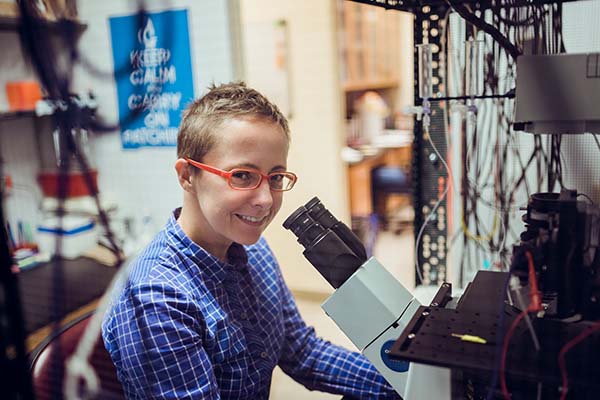
Polina Lishko
Molecular and Cell BiologyPolina Lishko is a former Assistant Professor of Cell and Developmental Biology in the Department of Molecular and Cell Biology.
Polina Lishko was a 2022 Bakar Prize recipient.
Project Description
Our goal is to repurpose an FDA-approved compound and develop an ophthalmic formulation to revitalized the function of aged retinal pigment epithelium (RPE)- the tissue critical to support healthy retina and ensure normal vision. The RPE dysfunction is one of the main causes of age-related macular degeneration- a leading cause of blindness in the US. The molecular target our group is working on has been verified by human and mouse genetics and represents an essential component of functional RPE. A small molecule lead compound has been successfully evaluated using in vitro assays and animal studies are underway to proof the effectiveness of our lead compound toward RPE restoration.
Spark Award Project
Plant-Derived Molecular Condoms as Non-Toxic Contraceptives
The urgent need for contraception worldwide concerns more than 200 million women. Almost a quarter of American women discontinue using hormonal methods of birth control within the first year, and ~54% of men discontinue using condoms within the same timeline, representing a large unmet demand for reliable, reversible and non-hormonal contraceptive compounds with minimal side effects. Polina Lishko has discovered several nontoxic plant-derived compounds that effectively inhibit the sperm “drilling” mode that is essential for successful fertilization. As a Bakar Fellow, she and colleagues will continue to evaluate these compounds’ safety and efficacy in blocking fertilization, using both in vitro and animal assays. They will also perform chemical screens for structurally related compounds with potentially even greater efficacy and begin to assess delivery routes for use in human contraceptive products.
Polina Lishko’s Story
On its quest to fertilize the egg, a human sperm cell confronts resistance left and right. It must overcome uterine immune defenses and navigate a maze of folds in the fallopian tube. As it reaches its goal, it encounters the thick, multi-layered egg-protective shield – the zona pellucida. There, its tail must shift into hyperdrive to power the sperm cell through the egg’s last barrier.

Photo credit: Mark Joseph Hanson
Last year, Polina Lishko, assistant professor of cell and developmental biology, and her senior researcher, Nadja Mannowetz, discovered in laboratory experiments that two natural compounds derived from plants can block human sperm’s ability to rev up to the drilling mode needed to penetrate the zona pellucida and fuse with the egg.
The compounds don’t kill the sperm. They act on the surface, maintaining the cells in a kind of limbo, unable to launch the final act, Lishko says. She considers the active molecules in both compounds promising candidates for an effective, non-toxic and non-hormonal contraceptive – a “molecular condom.”
“We are optimistic,” she says. “ Women respond very favorably to the possibility of using a non-hormonal contraceptive. And we know the product is needed.”
One of the compounds, pristimerin, is derived from a plant commonly known as Thunder God Vine. It has been used in traditional Chinese medicine to treat arthritis. Practitioners noticed that its use led to infertility during the time of treatment – a strong clue that the molecule could make a safe alternative contraceptive.
The second compound, called lupeol, is found in fruits, vegetables and in the succulent Aloe vera. It has been used for a wide variety of ailments, from inflammation to cancer.
With support from the Bakar Fellows Program, Lishko and Mannowetz are screening dozens of molecules closely related to the active ingredients in the two natural products in order to see if any are more effective.
So far, laboratory experiments have shown that lupeol remains the top candidate. In fact, the scientists have found that it is ten times more potent at blocking human sperm drilling power than the active component in many hormonal contraceptives.
Mannowetz is a Bakar Innovation Fellow, and she’s very excited about the potential of the basic research to make an out-size impact on women’s lives.

Photo credit: Mark Joseph Hanson
“Our finding is not just another published paper. What we are doing can help every woman of reproductive age out there,” she says.
Nearly 40 percent of women worldwide stop using birth control pills within a year – mainly due to side effects such as depression, weight gain, bleeding between periods and blood clots.
Current hormonal-based birth control options have a prolonged effect, since the active compounds remain in the body fat deposits, Lishko says. Even after a woman stops taking them, the hormones’ effects linger, continuing to prevent pregnancy for up to six months – a serious drawback in many cultures.
A sperm cell’s drilling ability is essentially powered by an electric current of calcium ions flowing into the cell through channels in its outer membrane. Normally, the egg’s progesterone triggers the channels to open.
Lishko and Mannowetz have found that progesterone binds to a protein on the sperm surface called ABHD2 to launch the ion current. The key molecular structures in lupeol and pristimerin are very similar to progesterone. The molecules dock to ABHD2 and prevent progesterone from issuing its drilling instructions.
To measure the calcium ion current in sperm cells’ membrane channels, Lishko and Mannowetz adapted a laboratory technique called the patch clamp, widely used in electrophysiology research. Their refinement was the first to allow its use with sperm cells, enabling them to demonstrate that lupeol and the related compounds blocked the drilling behavior.
The two scientists have started a company called YourChoice Therapeutics to advance the research toward commercialization. They must first demonstrate the key molecule’s effectiveness at blocking fertilization in nonhuman sperm and egg in vitro. The next step will be to test the contraceptive in animals.
Lishko is convinced the strategy can work, and that this kind of birth control is sorely needed.
“As we move into the future, non-hormonal contraceptives will be needed more and more in order to have a sustainable world,” she says.